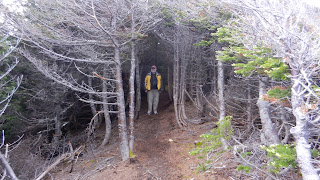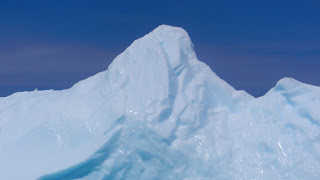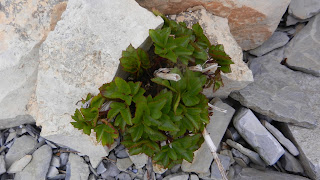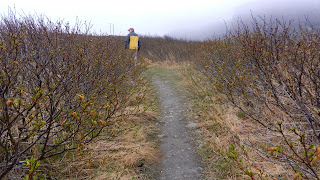I'd been satisfied just seeing the fox and her kits, but on the other side of the lighthouse on a rocky island just offshore we discovered our first puffin. Maybe hundreds had found a place to burrow and care for their young, but a bit too far for my Nikon Coolpix to get a good picture. It didn't matter; I was thrilled to see puffins at last!
...cruising through retirement aboard S/V Beowulf, M/S Sandpiper and our "land yacht" Shorebird, a 210 Versatile Roadtrek.
Sunday, October 21, 2012
Newfoundland9
After talking to a local lady who had taken an interest in Missy Moo, we moved on to pick up one more geocache at King's Cove Lighthouse. Not a quick grab, we hiked out to the lighthouse through a grassy meadow, but then we trudged over a partially washed out, suitable-only-for-Jeeps trail. I thought we might save ourselves by taking an alternate route back - wrong! We had to backtrack to the Roadtrek.
Up to this point in our trip, we had no problem finding a place for the night. I, however, failed to realize there was no campground in Bonavista; there was one 7 miles out of town, but we didn't want to move on just yet. A young girl at the Visitor's Center told us to just go out to "the cape" and park there for the night. The small, municipal park overlooking the rocky cape was perfect! We were all set to visit the lighthouse the next morning.
Hiking out across the rocky landscape to find a geocache we were stopped in our tracks while watching a wary lady fox and her two kits who make their home among the rocks near the lighthouse.
I'd been satisfied just seeing the fox and her kits, but on the other side of the lighthouse on a rocky island just offshore we discovered our first puffin. Maybe hundreds had found a place to burrow and care for their young, but a bit too far for my Nikon Coolpix to get a good picture. It didn't matter; I was thrilled to see puffins at last!
I'd been satisfied just seeing the fox and her kits, but on the other side of the lighthouse on a rocky island just offshore we discovered our first puffin. Maybe hundreds had found a place to burrow and care for their young, but a bit too far for my Nikon Coolpix to get a good picture. It didn't matter; I was thrilled to see puffins at last!
Newfoundland8
After leaving Twillingate and crossing the causeway, we noticed that the iceberg had shifted to the opposite side of the cove overnight. Instead of returning directly to the TransCan, we took the longer coastal route through Musgrave Harbour. All along the route we were able to view several large icebergs in the distance as we enjoyed the long, sandy beaches and fishing villages resembling Nova Scotia's Peggy's Cove.
Terre Nova National Park is bear country so we were given notice that no BBQ fires were allowed, but we got site #1 and not a soul was around until later on in the evening. This park like so many others in the Maritimes is crisscrossed with many hiking trails through forest or along the water's edge, so before leaving the park we took advantage of a beautiful, clear day and hiked the Coastal Trail around Sandy Pond.. Even though it was early in the season, we were able to find two or three clusters of Pitcher Plants.
As other plants grow taller and leaf out, these might be hard to pick out of the bog. As we walked around the pond, we found moose tracks, but did not see any lurking around. We also came across narrow paths used to portage canoes from one body of water to another. I enjoyed the colorful flowers along our path.
On our way to Bonavista, we still weren't ready to spend time on the TransCan, so we detoured onto Route 233 to check out Tickle Cove. Who could resist a place called Tickle Cove? The guidebooks note that Tickle Cove is the site of an interesting sea arch and I knew there was a geocache in the vicinity as well. Small, weatherworn and handpainted, signs led us to a narrow lane where we parked the Roadtrek and followed a footpath to the sea arch.
We were not expecting to see the awesome red slate that make up the sea arch. The arches, worn by the relentless pounding of the surf, defy gravity. What I mean is the slate making up the arch is vertical like a stack of paper that has fallen over.
Friday, September 7, 2012
Newfoundland7
We weren't the only ones to search for a better view of the iceberg. Several tour buses were tentatively negotiating the narrow, winding roads to capture that perfect shot. No wonder folks were excited: last year not one iceberg showed up until September. We had arrived at the perfect time to see icebergs. There had been two weeks of prolonged northeast winds pushing them in our direction.
On the way into town, we noticed several signs selling lobster; there were few if any on the western coast. We made our way through town and toward Peyton's Woods RV Campground. We had the pick of sites so we chose one closer to the road with a clear view of Back Harbour. Rocky and hilly, we had our choice of footpaths and trails to follow. We picked ourselves up and walked on over to Back Harbour.
Footpaths, used by many generations, abound and for good reason. If you are a fisherman and want to know what the seas are like, it is much more efficient to hike up the path to the top of the hill and look than to take your small boat out and find out the hard way.
Back at our campsite it was time to eat the lobster we bought in Labrador. Our Roadtrek has a very good freezer unit in the refrigerator, so our lobster was still in good condition.
The next morning we followed a trail into the nearby woods to find a geocache. Just off the path in an area that was rocky and moss-covered, the geocache was well-hidden; but we found it with a little bit of walking in circles. The trees affect the GPS's ability to get a good fix, but the Garmin 62st does the best job of it than any of my other GPS's.
We still had time to kill before our afternoon cruise to the iceberg, so we explored the area around Long Point Lighthouse. There are two geocaches in the area, but we did not have time to do the hikes and still make our boat. Instead, we walked the trail up to The Pinnacle. We parked the Roadtrek at the bottom of the hill in an area that looks to be an old fishing harbor, but is being used now for a playground and picnic area.
Long Point Lighthouse sits on top of one of the steepest and most imposing shorelines I have ever seen. Trails crisscross the landscape with signs warning of the treacherous paths ahead and down.
Taking the tour boat out to the iceberg was well-worth the time and expense. Just seeing a piece of ice 10,000 years old so close that I could see the intimate curves, the plastic-like surface glistening in the sun. I wanted to pat it, to speak to it, absorb it. See for yourselves.
The captain drove all the way around twice before he had to head back for his next cruise. Even though the winds were fairly light, motoring out the cove and around to Twillingate was a bit rolly, another way of saying we had 6-8 foot swells crashing into the rocks
On the way into town, we noticed several signs selling lobster; there were few if any on the western coast. We made our way through town and toward Peyton's Woods RV Campground. We had the pick of sites so we chose one closer to the road with a clear view of Back Harbour. Rocky and hilly, we had our choice of footpaths and trails to follow. We picked ourselves up and walked on over to Back Harbour.
Footpaths, used by many generations, abound and for good reason. If you are a fisherman and want to know what the seas are like, it is much more efficient to hike up the path to the top of the hill and look than to take your small boat out and find out the hard way.
Back at our campsite it was time to eat the lobster we bought in Labrador. Our Roadtrek has a very good freezer unit in the refrigerator, so our lobster was still in good condition.
The next morning we followed a trail into the nearby woods to find a geocache. Just off the path in an area that was rocky and moss-covered, the geocache was well-hidden; but we found it with a little bit of walking in circles. The trees affect the GPS's ability to get a good fix, but the Garmin 62st does the best job of it than any of my other GPS's.
We still had time to kill before our afternoon cruise to the iceberg, so we explored the area around Long Point Lighthouse. There are two geocaches in the area, but we did not have time to do the hikes and still make our boat. Instead, we walked the trail up to The Pinnacle. We parked the Roadtrek at the bottom of the hill in an area that looks to be an old fishing harbor, but is being used now for a playground and picnic area.
Long Point Lighthouse sits on top of one of the steepest and most imposing shorelines I have ever seen. Trails crisscross the landscape with signs warning of the treacherous paths ahead and down.
Taking the tour boat out to the iceberg was well-worth the time and expense. Just seeing a piece of ice 10,000 years old so close that I could see the intimate curves, the plastic-like surface glistening in the sun. I wanted to pat it, to speak to it, absorb it. See for yourselves.
The captain drove all the way around twice before he had to head back for his next cruise. Even though the winds were fairly light, motoring out the cove and around to Twillingate was a bit rolly, another way of saying we had 6-8 foot swells crashing into the rocks
Monday, September 3, 2012
Newfoundland6
Knowing we had to backtrack in order to pick up the TransCan, we detoured off of Hwy 430 and took Hwy 432 to Plum Point instead. It gave us a good view of the interior of the Northern Peninsula, thickly forested with Douglas Fir and White Pine. Along the way, we spotted several garden plots. Newfoundland is so rocky that residents search out a narrow space along the road with fertile soil and plant a garden. We were there in June, a bit like April in Indiana, so gardens were being turned (by hand) and row hills were established for root crops.
Along with the garden plots, there were many log "yards". Some contained piles of split logs while others were neatly stacked in rows. We assumed that snowmobiles pulling wooden sleds were used to haul the timber back near the road for cutting.
The long stretch of highway apparently didn't hold Missy Moo's interest, so a little vocabulary lesson might be in order:
Tuckamore - most of the hikes we have taken in search of geocaches have taken us across an area called tuckamore, an area of low-lying bushes and trees,often twisted and stunted by the constant winds. Tuckamore contains many plants that produce edible berries important to thousands of migratory birds and a staple in every larder such as bakeapple, partridgeberry, wild blueberry, squashberry and crowberry.
Tickle - A tickle is a narrow salt-water strait as an entrance to a harbor, considered treacherous because of its narrrowness and/or the tides.
It was almost a two-day trip back down the Northern Peninsula and then taking the TransCan until we came to Hwy 340 which would take us to Twillingate. Even though we were determined to explore every peninsula, we did bypass Baie Verte Peninsula. We could, however, add two moose and one coyote to our animal count.
Just before arriving in Twillingate, we spotted a large iceberg in a cove to our right. We turned around and took a road in that direction in hopes of seeing it close by, but the road ended in a cluster of homes and the rocky hills blocked our view. After crossing a bridge, we turned right again and did find ourselves across from the iceberg, but still not as close as we wanted. Driving through Twillingate, we took note of several tour companies offering whale watching and iceberg viewing. The next day we hoped to see that iceberg up close. The fun was just beginning.
Along with the garden plots, there were many log "yards". Some contained piles of split logs while others were neatly stacked in rows. We assumed that snowmobiles pulling wooden sleds were used to haul the timber back near the road for cutting.
The long stretch of highway apparently didn't hold Missy Moo's interest, so a little vocabulary lesson might be in order:
Tuckamore - most of the hikes we have taken in search of geocaches have taken us across an area called tuckamore, an area of low-lying bushes and trees,often twisted and stunted by the constant winds. Tuckamore contains many plants that produce edible berries important to thousands of migratory birds and a staple in every larder such as bakeapple, partridgeberry, wild blueberry, squashberry and crowberry.
Tickle - A tickle is a narrow salt-water strait as an entrance to a harbor, considered treacherous because of its narrrowness and/or the tides.
Just before arriving in Twillingate, we spotted a large iceberg in a cove to our right. We turned around and took a road in that direction in hopes of seeing it close by, but the road ended in a cluster of homes and the rocky hills blocked our view. After crossing a bridge, we turned right again and did find ourselves across from the iceberg, but still not as close as we wanted. Driving through Twillingate, we took note of several tour companies offering whale watching and iceberg viewing. The next day we hoped to see that iceberg up close. The fun was just beginning.
Labels:
iceberg,
roadside gardens,
tickle,
tuckamore,
Twillingate
Sunday, September 2, 2012
Newfoundland5
Before leaving the St Anthony area, we drove back to grab another geocache and to check out Fishing Point when the visibility was better. At another time we might even take in the Viking Feast at Leifsburdir, but we decided to spend our time at L'Anse au Meadows National Historic Site.
The Viking settlement dates back to 1000 A.D., and was probably only occupied less than 10 years, likely due to their nomadic nature. The husband and wife archaeologists who confirmed the authenticity of the site did so after finding one item: a small, bronze cloak pin. Not more than 3 inches in length, it was found on the site and is exactly the style and material used by Norsemen. Visiting this site is humbling. Spartan and isolated the land, the voyagers who traveled across oceans and land in search for adventure and new worlds deserve our homage:
The Viking settlement dates back to 1000 A.D., and was probably only occupied less than 10 years, likely due to their nomadic nature. The husband and wife archaeologists who confirmed the authenticity of the site did so after finding one item: a small, bronze cloak pin. Not more than 3 inches in length, it was found on the site and is exactly the style and material used by Norsemen. Visiting this site is humbling. Spartan and isolated the land, the voyagers who traveled across oceans and land in search for adventure and new worlds deserve our homage:
Saturday, September 1, 2012
Newfoundland4
Leaving Labrador on the 8 am ferry gave us enough time to continue on journey north. As the road parallels the Strait of Belle Isle, we enjoyed the added benefit of seeing more icebergs.
We couldn't pass up a morning walk around the winter headquarters of the village of Anchor Point, a few more miles up the road. Nothing remains but a few ramshackle ruins, but a wonderful boardwalk encircles the area. Villagers moved to this small, protected area during the winter, sheltering them from brisk, chilling winds. Residents used this area until the 1960's. One item caught my attention: there were numerous school teachers who came and then...left. I suspect life was not easy and its remote location was a challenge for young single men or women.
I couldn't wait to see the Trombolites in Flower Cove. We used The Marjorie Bridge and the Trombolites Walking Trail to view these bun-shaped rocks up close. I thought they resembled the tops of mushrooms. They're actually fossils of unicellular creatures. The Marjorie Bridge was the only access to the surrounding communities in the early 1900's. Rocks, rocks and more rocks; but peeping out of a crevasse was a tiny flower with immense courage.
After lunch at a local spot and a visit to the bank, we decided to move on to St Anthony where we could get our oil changed. We had driven 5000 miles at this point!! Waiting on our van, we had a pleasant talk with a couple who had grown up in the area. The man told us of how he helped with the Viking archaeological dig back in the '70's and his wife had actually grown up in Anchor Point, even living at the winter quarters. And, wouldn't you know it, we were cautioned to watch out for moose. Mike spoke to one of the customer service employees at the dealership who said that he had driven to the airport last night and had seen some 30 moose along the road. Bears and moose, bears and moose...
Before we left St Anthony, we drove on to Fishing Point in search of a geocache. By this time, the temperatures were hovering in the low 40's, the wind was strong and a foggy mist clouded our view. Mike was so accommodating; he led the way across the scrub-covered rock to uncover that geocache. I was so proud of his enthusiasm until I realized he was freezing and just wanted to get it done.
We spent the night at Triple Falls RV Campground 10 miles back and toward our next destination, the L'Anse au Meadows National Historic Site.
We couldn't pass up a morning walk around the winter headquarters of the village of Anchor Point, a few more miles up the road. Nothing remains but a few ramshackle ruins, but a wonderful boardwalk encircles the area. Villagers moved to this small, protected area during the winter, sheltering them from brisk, chilling winds. Residents used this area until the 1960's. One item caught my attention: there were numerous school teachers who came and then...left. I suspect life was not easy and its remote location was a challenge for young single men or women.
I couldn't wait to see the Trombolites in Flower Cove. We used The Marjorie Bridge and the Trombolites Walking Trail to view these bun-shaped rocks up close. I thought they resembled the tops of mushrooms. They're actually fossils of unicellular creatures. The Marjorie Bridge was the only access to the surrounding communities in the early 1900's. Rocks, rocks and more rocks; but peeping out of a crevasse was a tiny flower with immense courage.
After lunch at a local spot and a visit to the bank, we decided to move on to St Anthony where we could get our oil changed. We had driven 5000 miles at this point!! Waiting on our van, we had a pleasant talk with a couple who had grown up in the area. The man told us of how he helped with the Viking archaeological dig back in the '70's and his wife had actually grown up in Anchor Point, even living at the winter quarters. And, wouldn't you know it, we were cautioned to watch out for moose. Mike spoke to one of the customer service employees at the dealership who said that he had driven to the airport last night and had seen some 30 moose along the road. Bears and moose, bears and moose...
Before we left St Anthony, we drove on to Fishing Point in search of a geocache. By this time, the temperatures were hovering in the low 40's, the wind was strong and a foggy mist clouded our view. Mike was so accommodating; he led the way across the scrub-covered rock to uncover that geocache. I was so proud of his enthusiasm until I realized he was freezing and just wanted to get it done.
We spent the night at Triple Falls RV Campground 10 miles back and toward our next destination, the L'Anse au Meadows National Historic Site.
Subscribe to:
Comments (Atom)















































